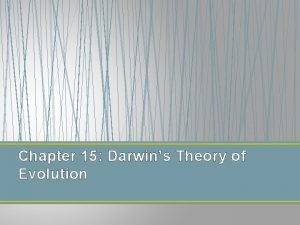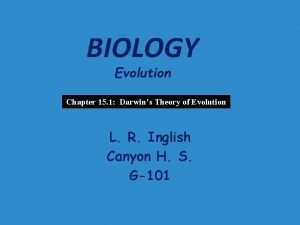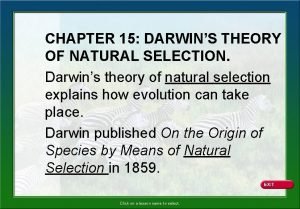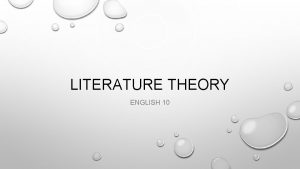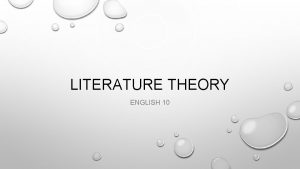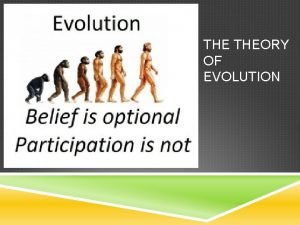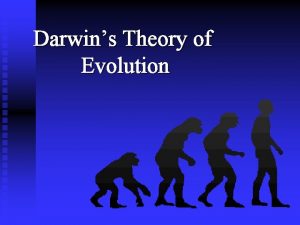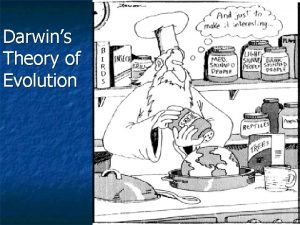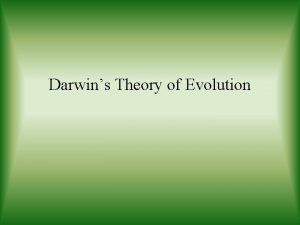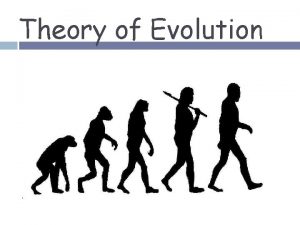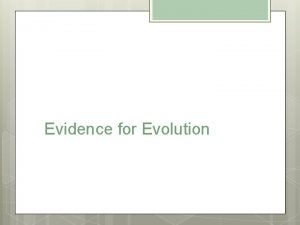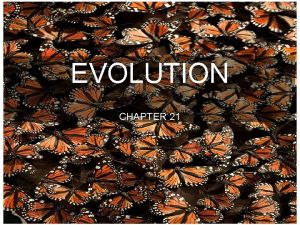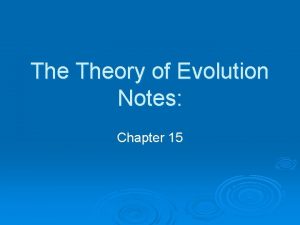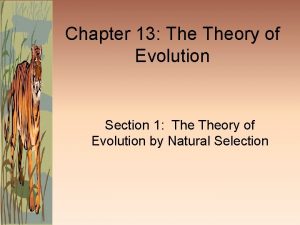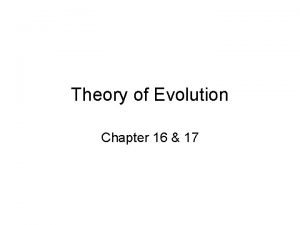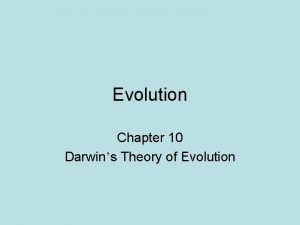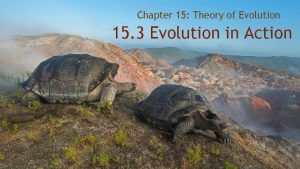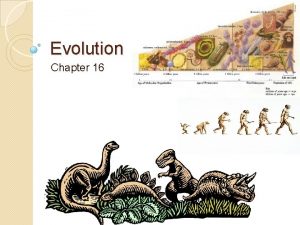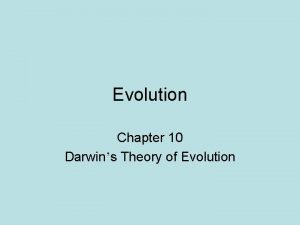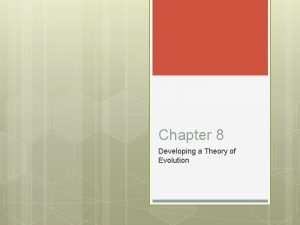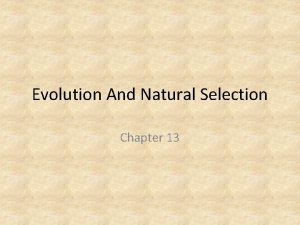Chapter 4 Evolution The Theory of Evolution English




























- Slides: 28

Chapter 4 Evolution




The Theory of Evolution • English scientist Charles Darwin is considered the founder of modern evolutionary theory. – Artifical Selection --- a technique in which a breeder selects particular traits. – Natural selection --- nature selects organisms with variations for a particular environment survive, reproduce, and pass on traits to the next generations.

ARTIFICIAL SELECTION • Human influences on genes of populations – Plants-corn, fruits, etc – Animals-dogs, cattle, horses, etc – Resistance-pesticide/antibiotic • Physiological Adaptations…can be rapid

NATURAL SELECTION • Organisms produce more than can survive • Environment is hostile, limited resources • Organisms differ in traits • Some inherited traits provide advantage • Each succeeding generation contains proportionately more organisms with advantageous traits

Defining Evolution • Evolution---gradual change over time; evolution is an unguided, unplanned process of random mutations and natural selection. – Microevolution– minor variations that occur in populations over time.

--- Macroevolution--- the emergence of major innovations or the unguided development of new structures (like wings), new organs (like lungs), and body plans (like the origin of insects and birds). The molecules to frogs, to apes, to man evolution.

Adaptations • Any variation that aids an organism’s chances of survival in its environment • Examples

Camouflage

Warning Coloration

Mimicry

Protective Covering

Other Evidence • Fossils • Anatomy – Homologous structures – Analogous structures – Vestigial structures • Embryology • Biochemistry

Fossils

Homologous Structures

Analogous Structures

Vestigial Structures

Embryology

Better Photo of Embryology

Biochemistry

Mechanisms of Evolution • Population Genetics – Allele frequency – Genetic equilibrium • Changes in Genetic Equilibrium – Any factor that affects allelic frequency

Types of Selection • Stabilizing-favors average • Directional-favors one extreme • Disruptive-favors both extremes




Evolution Of Species • • Speciation-evolution of new species Geographic Isolation Reproductive Isolation Gradualism-species originate through gradual series of adaptations
 Chapter 15 darwin's theory of evolution
Chapter 15 darwin's theory of evolution Chapter 17 darwin's theory of evolution
Chapter 17 darwin's theory of evolution Chapter 15 darwin's theory of evolution section review 15-1
Chapter 15 darwin's theory of evolution section review 15-1 Chapter 15 darwin's theory of evolution section 15-1
Chapter 15 darwin's theory of evolution section 15-1 Natural selection
Natural selection Hình ảnh bộ gõ cơ thể búng tay
Hình ảnh bộ gõ cơ thể búng tay Frameset trong html5
Frameset trong html5 Bổ thể
Bổ thể Tỉ lệ cơ thể trẻ em
Tỉ lệ cơ thể trẻ em Voi kéo gỗ như thế nào
Voi kéo gỗ như thế nào Chụp phim tư thế worms-breton
Chụp phim tư thế worms-breton Alleluia hat len nguoi oi
Alleluia hat len nguoi oi Các môn thể thao bắt đầu bằng tiếng bóng
Các môn thể thao bắt đầu bằng tiếng bóng Thế nào là hệ số cao nhất
Thế nào là hệ số cao nhất Các châu lục và đại dương trên thế giới
Các châu lục và đại dương trên thế giới Công thức tiính động năng
Công thức tiính động năng Trời xanh đây là của chúng ta thể thơ
Trời xanh đây là của chúng ta thể thơ Cách giải mật thư tọa độ
Cách giải mật thư tọa độ 101012 bằng
101012 bằng độ dài liên kết
độ dài liên kết Các châu lục và đại dương trên thế giới
Các châu lục và đại dương trên thế giới Thơ thất ngôn tứ tuyệt đường luật
Thơ thất ngôn tứ tuyệt đường luật Quá trình desamine hóa có thể tạo ra
Quá trình desamine hóa có thể tạo ra Một số thể thơ truyền thống
Một số thể thơ truyền thống Cái miệng nó xinh thế
Cái miệng nó xinh thế Vẽ hình chiếu vuông góc của vật thể sau
Vẽ hình chiếu vuông góc của vật thể sau Thế nào là sự mỏi cơ
Thế nào là sự mỏi cơ đặc điểm cơ thể của người tối cổ
đặc điểm cơ thể của người tối cổ V cc
V cc


